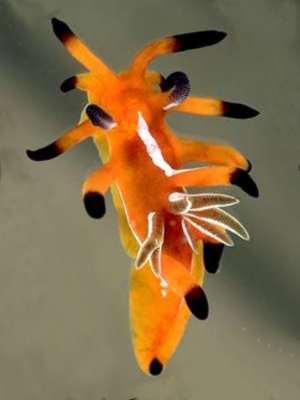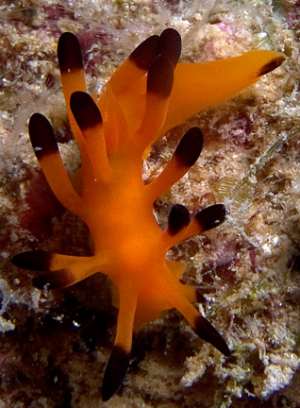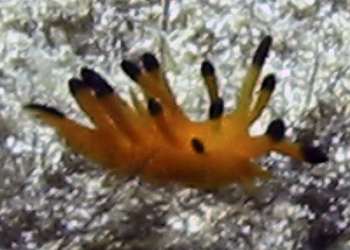
Okenia mellita
Rudman, 2004
Order: NUDIBRANCHIA
Suborder: DORIDINA
Superfamily: ANADORIDOIDEA
Family: Goniodorididae
DISTRIBUTION
Known only from eastern Australian waters.
PHOTO
Split Solitary Is, Coffs Harbour, New South Wales, Australia, February 1993, 18 mm long, AM C172896. Photo: W.B. Rudman.
The body is relatively high and there are 5 large lateral papillae along the mantle edge on each side of the body. The middle 3 on each side are the longest, about twice the width of the body. These papillae often wave around and can be held vertically or folded over the body. There is also a single long mediodorsal papilla, just in front of the gills. The gills are long and simple and arranged in 3 clusters, one in front of the anal papillae, and one on either side. The rhinophores are similar in shape and length to the dorsal papillae.
The background colour of the body is orange. The mantle papillae are all tipped with black, and there is a black tip to the oral tentacles, and a black spot on the posterior tip of the foot. There is also an opaque white line down the dorsal midline from between the rhinophores to the base of the medio-dorsal papilla just in front of the gills. The white line extends approximately halfway up the anterior face of this papilla. A white line runs along each side of the body and around the anterior end just below the lateral papilla. A branch of this line runs up the ventral, or outer, face of each papilla to just below the black tip. The rhinophore stalk is translucent orange and the club is black. A white line runs up the posterior midline of the rhinophore, partly on the stalk and partly on the club. The gills are a translucent orange with opaque white edging.
The orange colour pattern of Okenia mellita, with black-tipped papillae and white lines is quite unique in the genus. The name mellita comes from the Latin words for honey, honeyed, a reference to the golden orange-yellow colour of the animal. It is one of group of larger species in which there is no distinct ridge to differentiate the edge of the mantle. We have no information on the natural history of this species, but the strongly developed radular teeth and jaw elements, suggest this species could feed on a bryozoan with a calcified skeleton. See message #12641 for information on radula.
-
Rudman, W.B. (2004) Further species of the opisthobranch genus Okenia (Nudibranchia: Goniodorididae) from the Indo-West Pacific. Zootaxa, 695: 1-70.
Rudman, W.B., 2004 (December 21) Okenia mellita Rudman, 2004. [In] Sea Slug Forum. Australian Museum, Sydney. Available from http://www.seaslugforum.net/find/okenmell
Related messages
Okenia mellita - new area of Ningaloo Reef
April 16, 2005
From: Kristin Anderson

The other day I found another orange and black nudi that may be an Okenia mellita. This one was in a completely different area and much deeper than the others.
Locality: Ningaloo Reef, Western Australia, Indian Ocean. Depth: 22 m. Length: 2 cm. 28 March 2005. Photographer: Kristin Anderson
Kristin Anderson
kristin@exmouthdiving.com.au
Anderson, K.J., 2005 (Apr 16) Okenia mellita - new area of Ningaloo Reef. [Message in] Sea Slug Forum. Australian Museum, Sydney. Available from http://www.seaslugforum.net/find/13465Dear Kristin,
It looks like you have a resident population of this species. It certainly looks like O. mellita, except for the absence of white lines. As I mentioned before I would need to look at its anatomy to be sure. It would be interesting to know what it fed on. I suspect an encrusting bryozoan, so if you have any photos of it on a possible food source they would be interesting to see.
Best wishes,
Bill Rudman
Re: Okenia mellita from southern New South Wales
January 2, 2005
From: Leander Wiseman
Dear Bill,
Thanks for your reply. Its great to see the forum back, even better to find out the (new) identity of this nudi!! Will look out for a feeding shot for sure.
Happy New Year
Leander
leanderwiseman@yahoo.com.au
Wiseman, L., 2005 (Jan 2) Re: Okenia mellita from southern New South Wales. [Message in] Sea Slug Forum. Australian Museum, Sydney. Available from http://www.seaslugforum.net/find/12874Re: Okenia cf. mellita - Ningaloo Reef
January 1, 2005
From: Kristin Anderson

Dear Bill.
Thanks for your reply. Here's a not so great shot of the bodyn ... I will keep looking for another one and for my older film images (in a box somewhere!)
Locality: Exmouth Gulf, Western Australia, Indian Ocean
Depth: 10 m. 22 February 2002. silt/sand bottom; limestone & hard coral formations. Photographer: Kristin Anderson
Kristin Anderson
kristin@exmouthdiving.com.au
Anderson, K.J., 2005 (Jan 1) Re: Okenia cf. mellita - Ningaloo Reef. [Message in] Sea Slug Forum. Australian Museum, Sydney. Available from http://www.seaslugforum.net/find/12871Thanks Kristin,
I look forward to some more photos. It certainly looks like a species of Okenia. I would need to look at its anatomy to see if it is a colour form of O. mellita or not.
Best wishes,
Bill Rudman
Okenia cf. mellita - Ningaloo Reef
December 31, 2004
From: Kristin Anderson

Dear Bill,
Here is my most recent shot of this rarely seen nudibranch. I think it might be Okenia mellita - but notice that it is only noted from Eastern Australia so far.
Details of this shot are below, but I also have photos of it from the Muiron Islands, similar depth and surrounds. I have also seen one in Coral Bay but do not seem to have a photo of it that I can find.
Locality: Lighthouse Bay, Exmouth, Ningaloo Reef. Western Australia, Indian Ocean
Depth: 12 m. Length: 15 mm. 14 April 2004
Limestone base with hard coral reef; sandy surrounds
Photographer: Kristin Anderson
Kristin Anderson
kristin@exmouthdiving.com.au
Anderson, K.J., 2004 (Dec 31) Okenia cf. mellita - Ningaloo Reef. [Message in] Sea Slug Forum. Australian Museum, Sydney. Available from http://www.seaslugforum.net/find/12862Dear Kristin,
Certainly the colour looks like Okenia mellita, but it appears to lack the white markings found in eastern Australian specimens. I can't see the rhinophores or gills, and I am not sure from the photo if this is two animals together or one animal bent around so its head and tail are together. A photo showing its shape would be useful.
Best wishes,
Bill Rudman
Okenia mellita from southern New South Wales [2]
December 22, 2004
From: Dave Harasti


Hi Bill,
Congratulations on the new look forum and getting it up and running again. I'm sure there are many 'branchers' around the world that will be very happy.
I saw that you had created a page for Okenia mellita so I thought I'd send you a couple of shots of it from April 2004 to add to your page.
Locality: Bowen Island, Jervis Bay, New South Wales, Australia.
Depth: 27 metres
Length: 3 cm
15 April 2004
On sand moving between reef
Photographer: Dave Harasti
Cheers,
Dave
info@daveharasti.com
Harasti, D., 2004 (Dec 22) Okenia mellita from southern New South Wales [2]. [Message in] Sea Slug Forum. Australian Museum, Sydney. Available from http://www.seaslugforum.net/find/12810Dear Dave,
Thanks for the photos. They show the white markings on the side of the body very clearly. I thought I would have a few days to get things organised before new messages started appearing, but the first arrived about 2 hours after we went live again.
As I said to Leander [message #11872 ], If you see this species feeding, a photo would be very welcome.
Best wishes,
Bill Rudman
Okenia mellita from southern New South Wales
December 22, 2004
From: Leander Wiseman

Hi Bill,
I photographed this nudi on a wall at Lighthouse Reef, Ulladulla, New South Wales, Australia, at a depth of approximately 20 m on the 2nd January 2004.
Coleman's Nudibranchs of the South Pacific descibes it as of the Okenia genus.
I was hoping to find out a bit more about it ... and know what it actually is. I have seen this species on about 3 other occasions in Jervis Bay, but this is the first one I've been able to get a photo of.
cheers
Leander
leanderwiseman@yahoo.com
Wiseman, L., 2004 (Dec 22) Okenia mellita from southern New South Wales. [Message in] Sea Slug Forum. Australian Museum, Sydney. Available from http://www.seaslugforum.net/find/11872Dear Leander,
I retrieved your message from the large backlog that has built up while the Forum has been inoperable as it deals with Okenia mellita, a newly named species of Okenia I posted a page on yesterday.
We now know something about its anatomy, and that it is only known from the coast of New South Wales. What would be nice to know is something about its biology. We presume that like other species of the genus, it is a bryozoan feeder, but it would be nice to see some photos of it actually feeding, with a nice close-up photo of the bryozoan.
Best wishes
Bill Rudman
Radula of Okenia mellita
December 21, 2004
From: Bill Rudman

To accompany the Fact Sheet on Okenia mellita here are some SEM photos of the radular teeth. The radular formula is 30(+1) x 1.1.0.1.1 The innermost tooth has a broad base and a long elongate pointed cusp with many (30+) small, pointed denticles along the cutting edge. The much smaller outer teeth have a broad quadrangular base with a small recurved cusp which is folded under in the accompanying SEM photo. In general, the inner teeth and the jaw elements appear to be strongly chitinised. If morphology is a guide to function, I would suspect that this species feeds on a bryozoan with a calcified skeleton.
PHOTOS: Scanning electron micrographs of radula. A, Section of whole radula. B, Inner left radular teeth to show fine denticulation along cutting edge of tooth. Montague Is., New South Wales, Australia, 28 December 1977, AM C108509. Scale bar = 10 µm. Photo: G. Avern.
Bill Rudman
Rudman, W.B., 2004 (Dec 21) Radula of Okenia mellita. [Message in] Sea Slug Forum. Australian Museum, Sydney. Available from http://www.seaslugforum.net/find/12641